
The luna moth, also called the American moon moth, is a Nearctic moth in the family Saturniidae, subfamily Saturniinae, a group commonly named the giant silk moths.
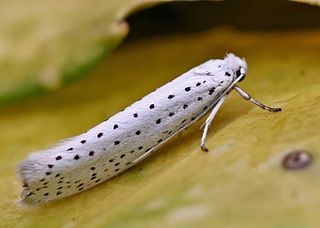
The family Yponomeutidae are known as the ermine moths, with several hundred species, most of them in the tropics. The larvae tend to form communal webs, and some are minor pests in agriculture, forestry, and horticulture. Adult moths are minor pollinators.

Papilio glaucus, the eastern tiger swallowtail, is a species of butterfly native to eastern North America. It is one of the most familiar butterflies in the eastern United States, ranging north to southern Ontario, Canada, and is common in many different habitats. It flies from spring until fall, during which it produces two to three broods. Adults feed on the nectar of many species of flowers, mostly from those of the families Apocynaceae, Asteraceae, and Fabaceae. P. glaucus has a wingspan measuring 7.9 to 14 cm. The male is yellow with four black "tiger stripes" on each forewing. Females may be either yellow or black, making them dimorphic. The yellow morph is similar to the male, but with a conspicuous band of blue spots along the hindwing, while the dark morph is almost completely black.

Pieris rapae is a small- to medium-sized butterfly species of the whites-and-yellows family Pieridae. It is known in Europe as the small white, in North America as the cabbage white or cabbage butterfly, on several continents as the small cabbage white, and in New Zealand as the white butterfly. The butterfly is recognizable by its white color with small black dots on its wings, and it can be distinguished from P. brassicae by its larger size and the black band at the tip of its forewings.

Pieris brassicae, the large white, also called cabbage butterfly, cabbage white, cabbage moth (erroneously), or in India the large cabbage white, is a butterfly in the family Pieridae. It is a close relative of the small white, Pieris rapae.

The common blue butterfly or European common blue is a butterfly in the family Lycaenidae and subfamily Polyommatinae. The butterfly is found throughout the Palearctic and has been introduced to North America. Butterflies in the Polyommatinae are collectively called blues, from the coloring of the wings. Common blue males usually have wings that are blue above with a black-brown border and a white fringe. The females are usually brown above with a blue dusting and orange spots.

Hyalophora cecropia, the cecropia moth, is North America's largest native moth. It is a member of the family Saturniidae, or giant silk moths. Females have been documented with a wingspan of five to seven inches or more. These moths can be found all across North America as far west as Washington and north into the majority of Canadian provinces. Cecropia moth larvae are most commonly found on maple trees, but they have also been found on cherry and birch trees among many others. The species was first described by Carl Linnaeus in his 1758 10th edition of Systema Naturae.

Dryocampa rubicunda, the rosy maple moth, is a small North American moth in the family Saturniidae, also known as the great silk moths. It was first described by Johan Christian Fabricius in 1793. The species is known for its wooly body and pink and yellow coloration, which varies from cream or white to bright pink or yellow. Males have bushier antennae than females, which allow them to sense female pheromones for mating.

The giant swallowtail is the largest butterfly in North America. It is abundant through many parts of eastern North America; populations from western North America and down into Panama are now considered to belong to a different species, Papilio rumiko. Though it is often valued in gardens for its striking appearance, its larval stage can be a serious pest to citrus farms, which has earned its caterpillars the names orange dog or orange puppy. The giant swallowtail caterpillars possess remarkable camouflage from predators by closely resembling bird droppings. They use this, along with their osmeteria, to defend against predators such as wasps, flies, and vertebrates.

Atalopedes campestris is a small grass skipper butterfly. It has a wingspan of 35–41 mm. Male is orange, edged with brown, and has a large brown-black stigma. Female is darker with lighter markings in the center of the wing.

The Mediterranean flour moth or mill moth is a moth of the family Pyralidae. It is a common pest of cereal grains, especially flour. This moth is found throughout the world, especially in countries with temperate climates. It prefers warm temperatures for more rapid development, but it can survive a wide range of temperatures.

The bird-cherry ermine is a species of moth in the family Yponomeutidae, the ermine moths. The wingspan of the moth ranges from 16 to 25 mm. The insect was first described in 1758 by the Swedish naturalist Carl Linnaeus who gave it the name Phalaena evonymella; it was later transferred to the genus Yponomeuta, becoming Yponomeuta evonymella. The moth can be found in the whole of Europe and the northern and eastern part of Asia.
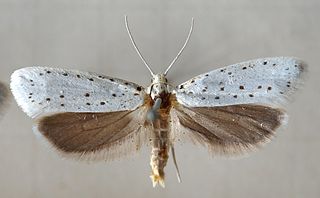
Yponomeuta cagnagella, the spindle ermine, is a moth from the family Yponomeutidae, the ermine moths. The wingspan of the moth ranges from 19 to 26 millimetres. The head is white. Forewings are white; four longitudinal series of few black dots, first not reaching middle, second beginning near before middle, lowest including 4-7 dots; some additional black dots before termen; cilia white. Hindwings are dark grey. The larva is pale greyish-yellowish; spots black; head black.
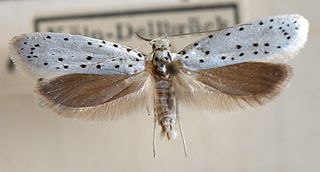
Yponomeuta rorrella is a lepidopteran from the family Yponomeutidae, the ermine moths, probably a migrant, but abundantly found in Britain, mostly concentrated in Northumberland.
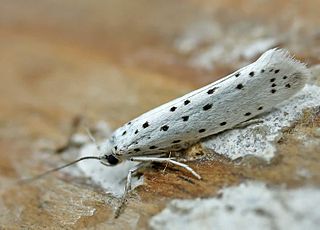
Yponomeuta padella is a lepidopteran from the family Yponomeutidae, the ermine moths. It is also known as the cherry ermine

Acronicta rumicis, the knot grass moth, is a species of moth which is part of the genus Acronicta and family Noctuidae. It was first described by Carl Linnaeus in his 1758 10th edition of Systema Naturae. It is found in the Palearctic region. A. rumicis lives and feeds on plants located in wide-open areas. At its larval stage, as a caterpillar, it causes such a large impact as a crop pest that it has received much attention and research. A. rumicis feeds on maize, strawberries and other herbaceous plants.

Syssphinx bicolor, the honey locust moth, is a North American moth in the family Saturniidae.

Ochrogaster lunifer, the bag-shelter moth or processionary caterpillar, is a member of the family Notodontidae. The species was first described by Gottlieb August Wilhelm Herrich-Schäffer in 1855. Both the larval and adult forms have hairs that cause irritation of the skin (urticaria). The adult moth has a woolly appearance and its wings can grow to be about 5.5 cm across. The larvae feed on Grevillea striata at night and reside in brown silken bag nest during the day.
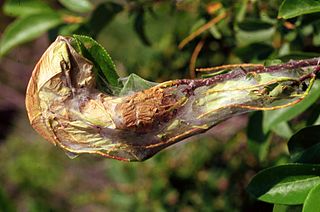
Archips cerasivorana, the ugly-nest caterpillar moth, is a species of moth of the family Tortricidae. The caterpillars of this species are known to create nests by tying the leaves of their host plant together. Within the nests, they live and feed off the leaves that have been tied together. The larvae are brownish or greenish yellow with a shiny dark brown head. Larvae can be found from May to July. The species overwinters as an egg, and pupation takes place within the nest. Caterpillars are seen to follow one another in trails, a behavior prompted by the release of signaling pheromones from their spinnerets.

Trabala pallida is a species of moth in the family Lasiocampidae. They can be found from Southeast China, south throughout Thailand and most of Sundaland. One subspecies is Trabala pallida montana.























